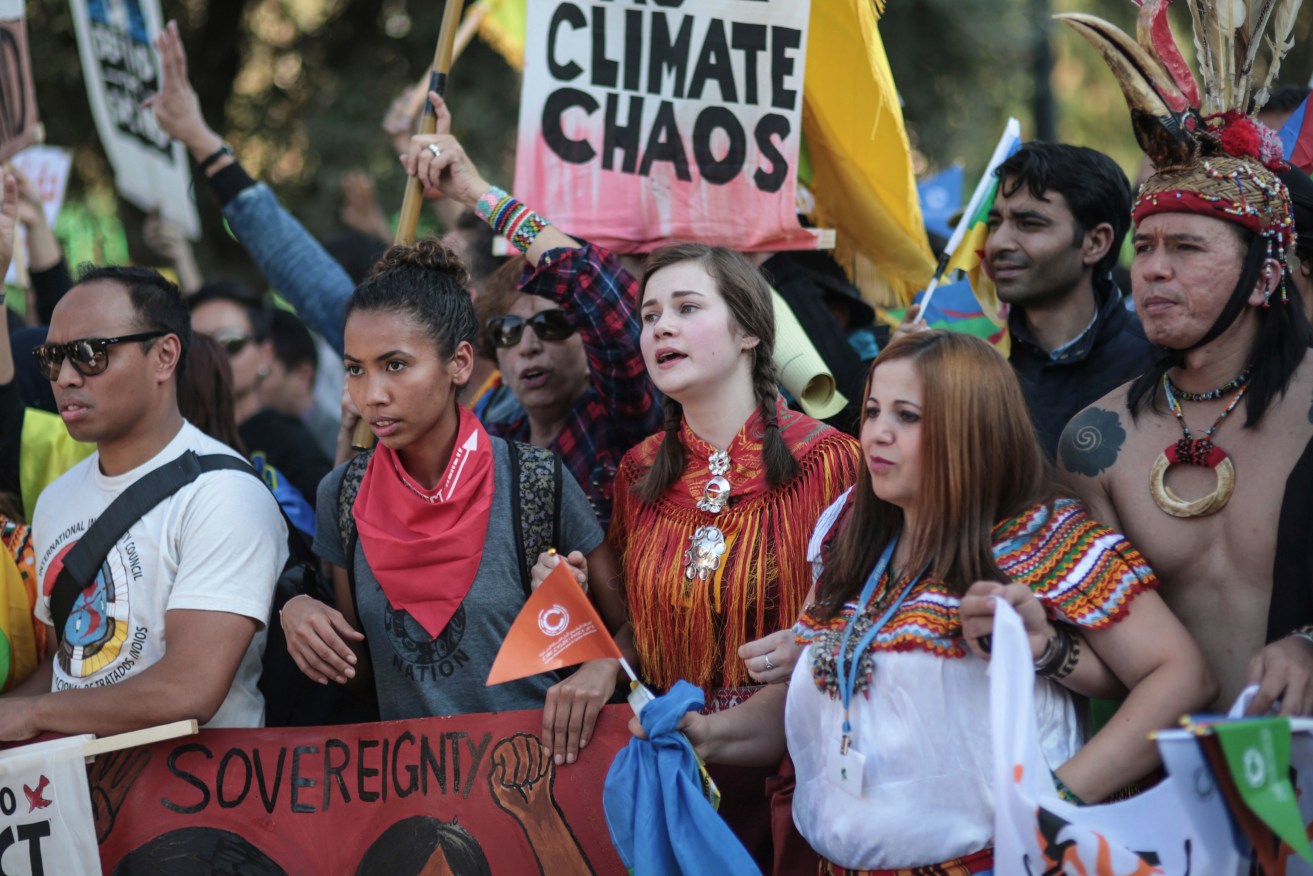Sweltering 2016 to set heat record
The world is set to notch up a new heat record in 2016 after a sizzling 2015 as global warming stokes more floods and rising sea levels, the UN weather agency has warned.

Hundreds urge world leaders to take action to combat climate change, in a march coinciding with the Climate Conference in Marrakech, Morocco. Photo: AP/Mosa'ab Elshamy
The World Meteorological Organization (WMO) says this year will be the warmest since records began in the late 19th century, with average surface temperatures 1.2 degrees Celsius above pre-industrial times. Sixteen of the 17 hottest years recorded have been in this century.
“Another year. Another record,” WMO Secretary-General Petteri Taalas said in a statement in Marrakesh, Morocco, where almost 200 nations are discussing ways to slow climate change.
The heat, with impacts such as melting Greenland ice and damage to Australia’s Great Barrier Reef, was stoked by an El Nino weather event in the Pacific early in the year and by man-made greenhouse gases, mainly from burning fossil fuels.
“The extra heat from the powerful El Nino event has disappeared. The heat from global warming will continue,” Taalas said.
The WMO said it was “very likely” that 2016 would be the hottest, barring a freak chill in coming weeks.
Taalas also said extreme weather events had increased as a result of climate change.
“Because of climate change, the occurrence and impact of extreme events has risen,” he said.
“‘Once in a generation’ heat waves and flooding are becoming more regular. Sea level rise has increased exposure to storm surges associated with tropical cyclones.”
The talks have been overshadowed by Donald Trump’s election win.
President-elect Trump has called climate change a hoax and a source in his transition team says he is seeking quick ways to pull the US out of the 2015 Paris Agreement, which aims to shift the world economy away from fossil fuels towards renewable energy.
Earlier on Monday a scientific report projected that world carbon dioxide emissions were expected to stay flat for the third year in a row in 2016 and that US emissions would fall by 1.7 per cent in 2016, driven by declines in coal consumption.
Meanwhile, Trump is considering an oil billionaire and a North Dakota lawmaker for top posts as he moves to roll back President Barack Obama’s environmental and energy policies and allow unfettered production of oil, coal and natural gas.
Trump has vowed to rescind “all job-destroying Obama executive actions” and pledges to sharply increase oil and gas drilling on federal lands while opening up offshore drilling in the Atlantic Ocean and other areas where it is blocked.
Topping Trump’s to-do list is repealing the Clean Power Plan, Obama’s signature effort to limit carbon pollution from coal-fired power plants. The plan – the linchpin of Obama’s strategy to fight climate change – is currently on hold awaiting a court ruling.
Trump is also targeting recent Obama administration efforts to reduce air and water pollution that have been opposed by Republicans and industries that profit from the extraction and burning of fossil fuels, including a rule to protect small streams and wetlands and ozone regulations designed to cut down on smog.
Those under consideration for energy secretary include Harold Hamm, an Oklahoma oil tycoon and leading proponent of fracking, and North Dakota Rep Kevin Cramer, an early Trump supporter from a major oil drilling state, according to transition planning documents obtained by The Associated Press.
Venture capitalist Robert Grady, who worked in President George HW Bush’s administration, is listed as a contender to lead both the Energy and Interior departments.
Cramer told reporters on Monday he is happy to stay in Congress, especially “with a friend in the White House. And if another good friend like Harold Hamm would become secretary of energy, I’d feel like I won the lottery.”
A coalition of conservative states has challenged both the Clean Power Plan and the water rule, which expanded the definition of waters protected under the Clean Water Act to smaller non-navigable waters and seasonal tributaries.
The administration says the rule would safeguard drinking water for 117 million people, but Republicans and some Democrats representing rural areas say the regulations are costly, confusing and amount to a government power grab. Federal courts have put the rules on hold as judges review lawsuits.
Trump also is likely to move quickly to approve the Keystone XL oil pipeline from Canada, which Obama rejected last year. Trump highlighted the project at a campaign stop in Florida last month and listed it among his top priorities for the first 100 days of his administration.
Key findings
- Final six weeks of the year would have to be the coldest of the 21st century for the 2016 average temperature to drop below 2015.
- January-September global temperature 0.88 degrees above long-term average.
- 0.11 degrees above the record set in 2015.
- 1.2 degrees about pre-industrial temperature levels.
- 2016 temperatures boosted by very strong El Nino event.
- Northern and eastern Australia one degree or more above average
- Almost entire northern hemisphere, north of the tropics, was at least one degree above average.
- Parts of the Russian Arctic have been 6-7 degrees higher than average.
- Only areas having cooler-than-normal year are southern Western Australia and northern and central Argentina.
- Past 15 years are among the 16 warmest on record.
– AAP and agencies




